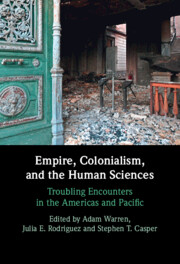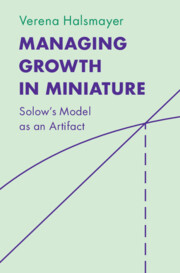Refine search
Actions for selected content:
13581 results in History of science and technology
Matthew Holmes, The Graft Hybrid: Challenging Twentieth-Century Genetics Pittsburgh: University of Pittsburgh Press, 2024. Pp. 320. ISBN 978-0-8229-4793-6. $55.00 (hardcover).
-
- Journal:
- The British Journal for the History of Science / Volume 58 / Issue 2 / June 2025
- Published online by Cambridge University Press:
- 04 November 2024, pp. 371-372
- Print publication:
- June 2025
-
- Article
- Export citation
Mark A. Ragan, Kingdoms, Empires, and Domains: The History of High-Level Biological Classification Oxford: Oxford University Press, 2023. Pp. 816. ISBN 978-0-19-764303-7. £107.50 (hardback).
-
- Journal:
- The British Journal for the History of Science / Volume 58 / Issue 1 / March 2025
- Published online by Cambridge University Press:
- 04 November 2024, pp. 159-160
- Print publication:
- March 2025
-
- Article
- Export citation

Five Innovations That Changed Human History
- Transitions and Impacts
-
- Published online:
- 01 November 2024
- Print publication:
- 21 November 2024
Michael Bresalier, Modern Flu: British Medical Science and the Viralisation of Influenza, 1890–1950 London: Palgrave Macmillan, 2023. Pp. xxvii + 458. ISBN 978-1-137-33953-9. £95.00 (hardcover).
-
- Journal:
- The British Journal for the History of Science / Volume 58 / Issue 1 / March 2025
- Published online by Cambridge University Press:
- 31 October 2024, pp. 151-152
- Print publication:
- March 2025
-
- Article
- Export citation
Gemma Almond-Brown, Spectacles and the Victorians: Measuring, Defining and Shaping Visual Capacity Manchester: Manchester University Press, 2023. Pp. 296. ISBN 978-1-5261-6135-2. £85.00 (hardcover).
-
- Journal:
- The British Journal for the History of Science / Volume 58 / Issue 1 / March 2025
- Published online by Cambridge University Press:
- 31 October 2024, pp. 189-190
- Print publication:
- March 2025
-
- Article
- Export citation
Adrian Johns, The Science of Reading: Information, Media, and Mind in Modern America Chicago: University of Chicago Press, 2023. Pp. 504. ISBN 978-0-226-82148-1. $32.50 (cloth).
-
- Journal:
- The British Journal for the History of Science / Volume 58 / Issue 2 / June 2025
- Published online by Cambridge University Press:
- 31 October 2024, pp. 377-378
- Print publication:
- June 2025
-
- Article
- Export citation
Philip Glahn and Cary Levine, The Future Is Present: Art, Technology, and the Work of Mobile Image Cambridge, MA: MIT Press, 2024. Pp. 336. ISBN 978-0-262-54807-6. $45.00 (paperback).
-
- Journal:
- The British Journal for the History of Science / Volume 58 / Issue 1 / March 2025
- Published online by Cambridge University Press:
- 31 October 2024, pp. 191-192
- Print publication:
- March 2025
-
- Article
- Export citation
Kenneth L. Caneva, Helmholtz and the Conservation of Energy: Contexts of Creation and Reception Cambridge, MA: MIT Press, 2021. Pp. 760. ISBN 978-0-262-04573-5. $125.00 (hardcover).
-
- Journal:
- The British Journal for the History of Science / Volume 58 / Issue 1 / March 2025
- Published online by Cambridge University Press:
- 31 October 2024, pp. 161-162
- Print publication:
- March 2025
-
- Article
- Export citation
Maria Eulàlia Gassó Miracle, Coenraad Jacob Temminck and the Emergence of Systematics (1800–1850) Leiden: Brill, 2021. Pp. 328. ISBN 978-90-04-41917-9. €129.00 (hardback).
-
- Journal:
- The British Journal for the History of Science / Volume 58 / Issue 1 / March 2025
- Published online by Cambridge University Press:
- 31 October 2024, pp. 157-158
- Print publication:
- March 2025
-
- Article
- Export citation
Heidi Morefield, Developing to Scale: Technology and the Making of Global Health Chicago: University of Chicago Press, 2023. Pp. 232. ISBN 978-0-226-82863-3. $30.00 (paper).
-
- Journal:
- The British Journal for the History of Science / Volume 58 / Issue 1 / March 2025
- Published online by Cambridge University Press:
- 31 October 2024, pp. 169-170
- Print publication:
- March 2025
-
- Article
- Export citation
Paul Warde, Libby Robin and Sverker Sörlin, The Environment: A History of the Idea Baltimore: Johns Hopkins University Press, 2021. Pp. 256. ISBN 978-1-4214-4002-6. $27.00 (paperback).
-
- Journal:
- The British Journal for the History of Science / Volume 58 / Issue 1 / March 2025
- Published online by Cambridge University Press:
- 31 October 2024, pp. 153-154
- Print publication:
- March 2025
-
- Article
- Export citation
Kamlesh Mohan, Science and Technology in Colonial India London: Routledge, 2022. Pp. 176. ISBN 978-1-032-36479-7. £96.00 (hardback).
-
- Journal:
- The British Journal for the History of Science / Volume 58 / Issue 1 / March 2025
- Published online by Cambridge University Press:
- 31 October 2024, pp. 185-186
- Print publication:
- March 2025
-
- Article
- Export citation
Lukas M. Verburgt (ed.), Debating Contemporary Approaches to the History of Science London: Bloomsbury Academic, 2024. Pp. 376. ISBN 978-1-3503-2623-1. £75.00 (hardback).
-
- Journal:
- The British Journal for the History of Science / Volume 58 / Issue 1 / March 2025
- Published online by Cambridge University Press:
- 31 October 2024, pp. 167-168
- Print publication:
- March 2025
-
- Article
- Export citation

Empire, Colonialism, and the Human Sciences
- Troubling Encounters in the Americas and Pacific
-
- Published online:
- 24 October 2024
- Print publication:
- 07 November 2024
-
- Book
-
- You have access
- Open access
- Export citation

Managing Growth in Miniature
- Solow's Model as an Artifact
-
- Published online:
- 24 October 2024
- Print publication:
- 07 November 2024
Thomas B. Robertson and Jenny Leigh Smith (eds.), Transplanting Modernity: The Environmental Legacy of International Development Pittsburgh: University of Pittsburgh Press, 2023. Pp. 320. ISBN 978-0-8229-4639-7. $50.00 (hardcover).
-
- Journal:
- The British Journal for the History of Science / Volume 58 / Issue 1 / March 2025
- Published online by Cambridge University Press:
- 18 October 2024, pp. 175-176
- Print publication:
- March 2025
-
- Article
- Export citation
Value, knowledge and reputation: zoological exchange by Australian museums, 1870–1900
-
- Journal:
- The British Journal for the History of Science / Volume 58 / Issue 1 / March 2025
- Published online by Cambridge University Press:
- 18 October 2024, pp. 81-100
- Print publication:
- March 2025
-
- Article
-
- You have access
- Open access
- HTML
- Export citation
Conclusion: Historical Geographies of Future Weather
-
- Book:
- The Observatory Experiment
- Published online:
- 05 October 2024
- Print publication:
- 10 October 2024, pp 235-246
-
- Chapter
- Export citation
Contents
-
- Book:
- The Observatory Experiment
- Published online:
- 05 October 2024
- Print publication:
- 10 October 2024, pp v-v
-
- Chapter
- Export citation
Copyright page
-
- Book:
- The Observatory Experiment
- Published online:
- 05 October 2024
- Print publication:
- 10 October 2024, pp iv-iv
-
- Chapter
- Export citation
